What is acupuncture?
Acupuncture originated in China nearly 2500 years ago as a holistic therapy meant to treat the whole patient rather than a specific condition. The earliest acupuncture tools were sharp pieces of stone, flint, bones or bamboo.
While it’s become one of the most popular complementary therapies worldwide, it didn’t gain popularity in the West until the 1970s.
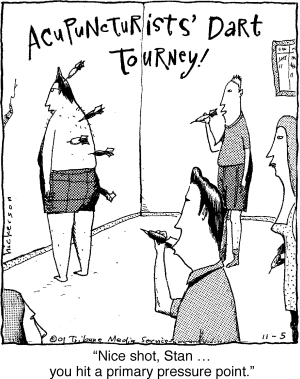
How is acupuncture performed?
Acupuncture involves puncturing the skin with a needle, but can include other types of stimulation to the epidermis. Modern acupuncture can also include electrostimulation through the inserted needles. The purpose of needle insertion is to alter the flow of Chi (or Qi) through body meridians. (More on Chi below.)
When needles are used as a method of treatment, they vary in size and length. Most are about one inch long. Needles up to three inches long can be used in fleshy areas like the glutes. To lower disease transmission, one-time disposable needles should be used.
Needle insertion can be just under the skin or into the muscle and can produce a mild ache or sense of heaviness, but is rarely sharply painful. Needles are usually left in place for 15 to 30 minutes. Between six and eight treatments might be required to detect any results, although patients may notice some immediate effects.
Balancing Chi
In traditional Chinese medicine (TCM), the normal flow of body energies or life force is called Chi (or Qi), and it’s in a constant state of flux. It’s thought that Chi circulates through meridians (energy pathways), just as blood circulates through vessels.
Unlike modern Western medicine, which focuses on “curing” disease symptoms, traditional Chinese medicine focuses on achieving a dynamic balance between the various elements that make up each person. Traditional practitioners claim that when Chi is out of balance, illness results. It’s been said that humans are born with a certain allotment of Chi, which we replenish with food and air.
TCM practitioners also look at the opposing but complementary forces of yin and yang. Yin pertains to cold, slow, dark, and quiet; it’s sometimes viewed as a “feminine” energy. Yang is hot, fast, bright, and loud; it’s sometimes viewed as a “masculine” energy.
According to TCM, yin and yang must be balanced to maintain optimal health. Chi can be bi-directional according to the yin or yang energy — for instance, raising or lowering blood pressure; increasing or decreasing gastric secretions, etc. It’s thought that acupuncture promotes this balance by using the body meridians through which Chi flows. There are 12 pairs of meridians associated with organs, joints and extremities. There is no known evidence for physical existence of these meridians.
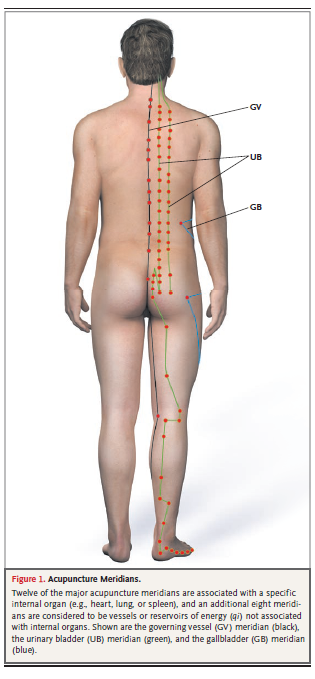
NEJM 2010;363:454-461.
Each meridian has five acupuncture points related to the five Chinese elements – earth, wood, water, metal and fire (not related to the periodic table of elements).
It’s thought that needling the meridian can improve the condition of the associated organ. Some of the meridian relationships are apparent, like the bladder relating to water. But some aren’t, like wood relating to the liver.
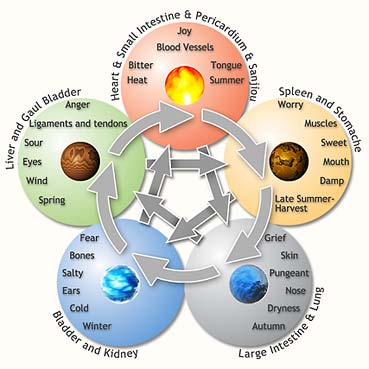
Harmful Chi is thought to contribute to illness and can arise from internal and external sources. Examples include wind, cold, heat, wetness, dryness, joy, anger, melancholy, obsessions, grief, fear, fright, irregular eating, excessive stress, lack of exercise, and trauma.
The flow of Chi is controlled by a biological clock allowing practitioners to assess the timing of symptoms (along with the actual symptoms) to get an idea of the organ affected. For example, if someone had a cough, asthma or tightness in the chest, it may be due to an excess or deficiency of lung meridian Chi, especially if the symptoms are noticed early in the morning when the lung meridian has a surge of energy.
Also, the pulse and tongue are checked by the acupuncturist to diagnose the flow of Chi and organ status.
Modern Western medicine’s interpretation
Modern medicine has proposed 5 interacting explanations for how acupuncture works.
1 – Local
Acupuncture may stimulate nerve fibers in the skin and muscles, triggering action potentials and the release of substances that can dilate vessels (increasing local blood flow). This may help to encourage tissue healing.
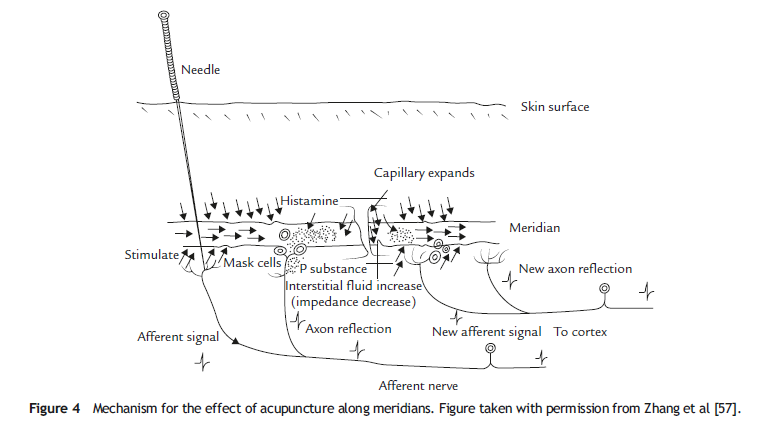
J Acupunc Meridian Stud 2010;3:1-9.
2 – Segmental
The action potentials that are triggered by the needle insertion can travel along the nerve and depress responses to painful stimulus, in part due to enkephalin release. This is likely the reason for pain relief. And when it comes to pain relief, some data indicate acupuncture can be as effective as morphine!
3 – Extrasegmental
Action potentials can go a long way. They can make their way up to the brain and stimulate the body’s pain-suppressing operations, in part due to endorphin release. This result doesn’t depend so much on needling specific areas of the body, rather, just getting enough nerve stimulation.
4 – Central regulatory
The hypothalamus and limbic system can be stimulated by acupuncture, which may have an overall calming effect and regulate the autonomic nervous system.
5 – Myofascial trigger points
We hear about myofascial release using foam rollers and tennis balls, but acupuncture can influence the fascia too. Small knots can form in tight muscles with repetitive use or injury. These knots might act as protective mechanisms ensuring the muscle rests/recovers, or it might just be a healing malfunction in the body. Either way, fascial knots are sensitive and acupuncture can help in their release. Moving the muscle through a full range of motion after treatment may assist in recovery.
The clinical data
Acupuncture sounds great – but isn’t it all just anecdotes? Is any of this legit science?
Evidence from clinical trials indicates that acupuncture isn’t just a placebo effect. Still, rigorous trials are difficult since it’s hard to mimic a needle or perform a “sham” puncture in blind studies, especially in cultures familiar with the practice.
Clinical research suggests that acupuncture is helpful for:
- Relief of nausea and vomiting
- Relief of back pain
- Relief of chronic knee pain
- Relief of post-operative dental pain
Beyond these areas, research hasn’t been accomplished, isn’t conclusive, or has shown no effect.
Data indicates that acupuncture is safe when a skilled practitioner is performing the treatment. Mild adverse events might include bleeding and drowsiness. Significant events are uncommon but might include infections, nerve/vessel injury, exacerbations of asthma, and seizure. All treatments should be performed lying down, due to the potential of fainting. Always avoid the use of embedded needles and self-acupuncture.
My acupuncture experience
While researching this article, I figured I should experience the world of acupuncture. Since I currently don’t have any illnesses or complaints, I requested a “general health” session, focusing on tendonitis (medial elbow) and cold hands (since I maintain a lean body year round, I’ve noticed colder extremities).
The practitioner showed me the needles (36 gauge, single-use disposable), explained her procedure, examined my pulse and tongue, and then moved forward with needle insertion.
She inserted one needle in each foot, two needles in each calf, two needles in my upper abdomen, one needle by each thumb, and one needle inside each elbow. Oh – and one needle in my forehead for relaxation.
I definitely felt all the punctures, and the needles on the right side of my abdomen, thumb, and calf resulted in some sharp and lingering pains. The practitioner told me this was Chi. I think it was my nerve endings.
After all the needles were inserted the practitioner told me to relax and take myself to a calm place. She turned off the lights and then left for about 12 minutes.
I wasn’t very relaxed because I didn’t want to move my body and bump a needle insertion. Also, my scalp started itching and I couldn’t itch it because I didn’t want to jam a needle into my head.
Let me be straight — I’m fine with needles. I donate blood, I’ve been certified in venipuncture, and I’ve even injected myself with veterinary vitamins when I was bodybuilding (don’t ask about it and don’t try it). But something about multiple small needles in my body at one time didn’t go very well. If you don’t like needles, you probably won’t like acupuncture.
When the practitioner returned, she explained that it can take up to 12 treatments to notice relief, depending on the ailment being addressed. She said my flow of Chi, pulse, and tongue were excellent. That’s always nice to hear.
I had very minimal bleeding at two of the insertion sites and there was some lingering dull pain in my calf, thumb and abdomen after leaving.
Keep in mind that I completed the acupuncture treatment for “general health,” and I don’t think the potential benefits outweighed the discomfort and cost ($75 for 90 minutes). I probably wouldn’t pursue acupuncture again unless I had a specific health concern.
Summary and recommendations
It’s difficult to draw strong conclusions since the acupuncture experience tends to be governed by social and psychological factors.
Acupuncture might be useful for the relief of nausea and vomiting, and some forms of pain relief. The effects seem to take place locally, along nerve segments, centrally, and at fascial trigger points.
Acupuncture does appear to be safe when working with an experienced practitioner. If you seek treatment, make sure to find a legit professional, see here for more: nccaom.org
Extra credit
Tattoo marks found on prehistoric human remains may have had a medical purpose similar to acupuncture. This was discovered around 3300 BC.
An unhealthy tongue can indicate buildup of harmful Chi.
One of the most respected medical universities in Canada, McMaster University, also offers a medical acupuncture program.
Semi-permanent acupuncture needles placed into the rim of the ear (see image below) have been used in the military to decrease pain.
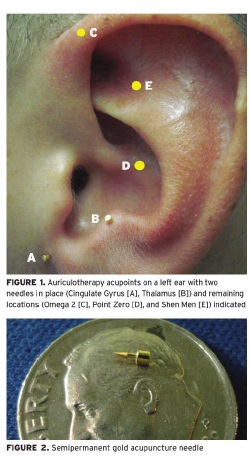
JAAPA 2010;23:51-52.
References
Click here to view the information sources referenced in this article.
Learn more
Want to get in the best shape of your life, and stay that way for good? Check out the following 5-day body transformation courses.
The best part? They're totally free.
To check out the free courses, just click one of the links below.




Share